UB-2 class (1915-18)
 German Empire – 30 submarines, UB-18 to UB-47
German Empire – 30 submarines, UB-18 to UB-47
WW1 German U-Boats
Brandtaucher | Forelle | U-1 | U-2 | U-3 class | U-5 class | U-9 class | U-13 class | U-17 class | U-19 class | U-23 class | U-43 class | U-57 class | U-63 class | U-87 class | U-93 class | U-139 class | U-142 class | UA | UB-I class | UB-II class | UB-III class | UC-I class | UC-II class | UC-III | Deutschland | UE-I class | UE-II class | U-Projects
UB-45 underway in 1916
The UB-II class. Second part of out tryptich on the WWI German UB type submarines (the coastal ones), the UB-II were an all-improvement of the criticitzed “tiny tadpoles” designed to operated from the Flanders in 1914. Built in 1945-16, almost twice as much (UB-18 to 47, 30 boats) served there as well as North sea, Baltic, Adriatic and Black sea (and mediterranean). Technically twice as large as the UB-I, faster, with more range and two engines but still a single propeller, they were also far better armed and were better appreciated by their numerous captains, most being awarded either the Royal House Order of Hohenzollern medal or the rarer Pour le Mérite, sinking a gargantuan number of ships for their small size. UB-40 for example, was an absolute top scorer with 100 ships (135,617 tons) and damaged 16 (60,629 tons) for a total of 196,246 tonnes which represented for these 270 tonnes boat a tonnage ratio of 730/1. UB-18, the lead boat was the secod top scorer with 127 ships for 484/1…
They also sank the battleship Gaulois, cruisers HMS Penelope and Grafton among others, liners such as the Franconia and many others. The last six served with the Pola Flotilla (under nominal Austro-Hungarian colors) and black sea. Next stop: The last and absolute best of the serie, the UB-III class (210 ordered), most produced submarine of WWI and direct ancestor of the Type VII of WW2 fame.
Design genesis of the UB-II
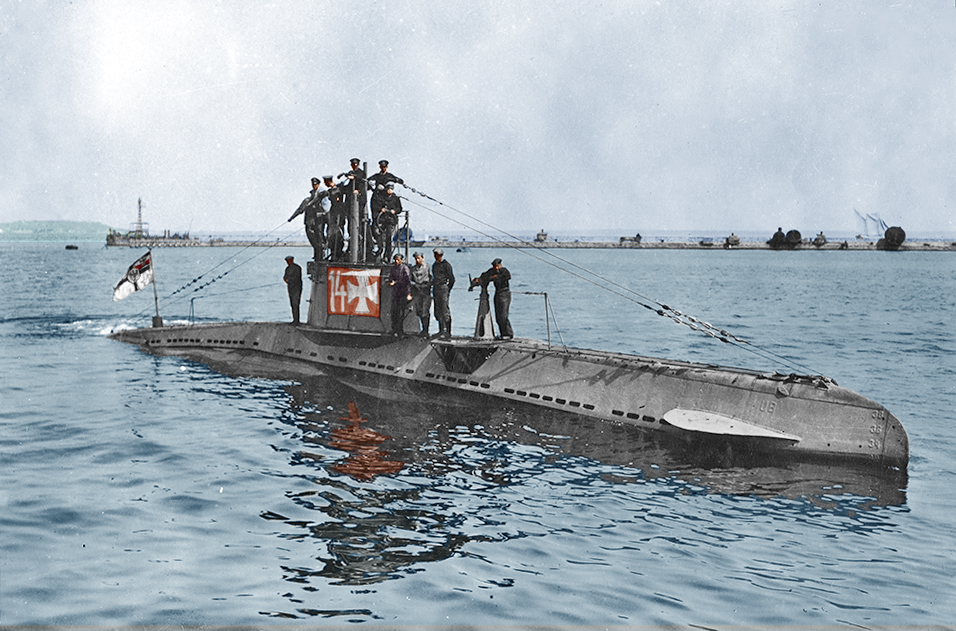 < Left: UB-I type for comparison. The Type UB II submarines or UB-2 class, were small coastal submarines of the German Imperial Navy, enlarged versions of the previous type UB I. They were considered way more effective, notably for their own tonnage vs/ sunken tonnage ratio, which was for some of the "sub aces", at a near 1/500 ratio. They repeated the single hull design but on a larger size, double the tonnage, while still considered coastal, In 1915-1916 some 30 were built at two different shipyards.
Their design addressed many of the shortomings observed with the UB I class.
To put things in their context, the latter has been designed to take advantage of the recent capture of French and Belgian ports. The flanders notably offered a formidable balcony on the north sea and channel, allowing U-Boats to avoid being based in the far more distant Jade Bay.
So close to operations, but also in shallow waters, small coastal U-Boats were required, cheaper and faster to built. In addition the UB-I type was designed to be cut in sections and transported by rail. They had some successes in operations, some even finding extra service in the Adriatic.
< Left: UB-I type for comparison. The Type UB II submarines or UB-2 class, were small coastal submarines of the German Imperial Navy, enlarged versions of the previous type UB I. They were considered way more effective, notably for their own tonnage vs/ sunken tonnage ratio, which was for some of the "sub aces", at a near 1/500 ratio. They repeated the single hull design but on a larger size, double the tonnage, while still considered coastal, In 1915-1916 some 30 were built at two different shipyards.
Their design addressed many of the shortomings observed with the UB I class.
To put things in their context, the latter has been designed to take advantage of the recent capture of French and Belgian ports. The flanders notably offered a formidable balcony on the north sea and channel, allowing U-Boats to avoid being based in the far more distant Jade Bay.
So close to operations, but also in shallow waters, small coastal U-Boats were required, cheaper and faster to built. In addition the UB-I type was designed to be cut in sections and transported by rail. They had some successes in operations, some even finding extra service in the Adriatic.
However critics were no long to come by:
-During trials they were hated by sailors as too cramped.
-Captains complained about their poor seworthiness in bad weather
-They also found them slow and underpowered in strong currents.
-They were noisy and shaky in surface, nicknamed “sewing machine”.
-They were also not fast enough to chase down steamers on surface
-Underwater endurance was low and rarely beyond an hour.
-Between a single propeller and machinery any failure, left them stranded.
-Their poor range obliged the Navy to tow them to station for longer distances.
-They had a tendency to break trim after firing torpedoes, with unreliable compensating tanks. The crew had to run to the stern to offset imbalance in many occasions.
In the end the “tin tadpoles” Type found service in three flotillas and met success, especially for their own tonnage/tonnage sunk ratio, which was far better than the surface fleet.
The German admiralty knew they the concept was valid, and would remain so if the front stayed static, which was likely; Thus, it was just all too natural to improve on the concept and try to adress all critics, leading to the improved UB-2 Type.
Final design
The weight of the boat was increased to 270 tons of surface displacement to accommodate these improvements. Saddle tanks were fitted to the sides of the pressure hull to allow greater fuel storage area. The hull was just larger in every way. To compare:
263–279 t (259–275 long tons) surfaced and 292–305 t (287–300 long tons) submerged versus 127/142 tonnes on UB-I
Length: 36.13–36.90 m (118 ft 6 in – 121 ft 1 in) versus 27.88–28.10 m (91 ft 6 in – 92 ft 2 in)
Beam: 4.36 m (14 ft 4 in) versus 3.15 m (10 ft 4 in)
Draught 3.66–3.75 m (12 ft – 12 ft 4 in) versus 3.03 m (9 ft 11 in)
Parts of these increases dimensions included the need to install a second powerplant. The beam was thus pushed by a meter, while the lenght was stretched by nearly 1/3 to increase internal room.
In the end, the crew of the UB-II comprised 23 versus 14 men (two officers and 21 ratings) so it was stull not “luxury”.
Armament was augmented too, to give them a bit more leeway in operations (see later). Problems with the trim tanks were apparently solved.
Hull Design
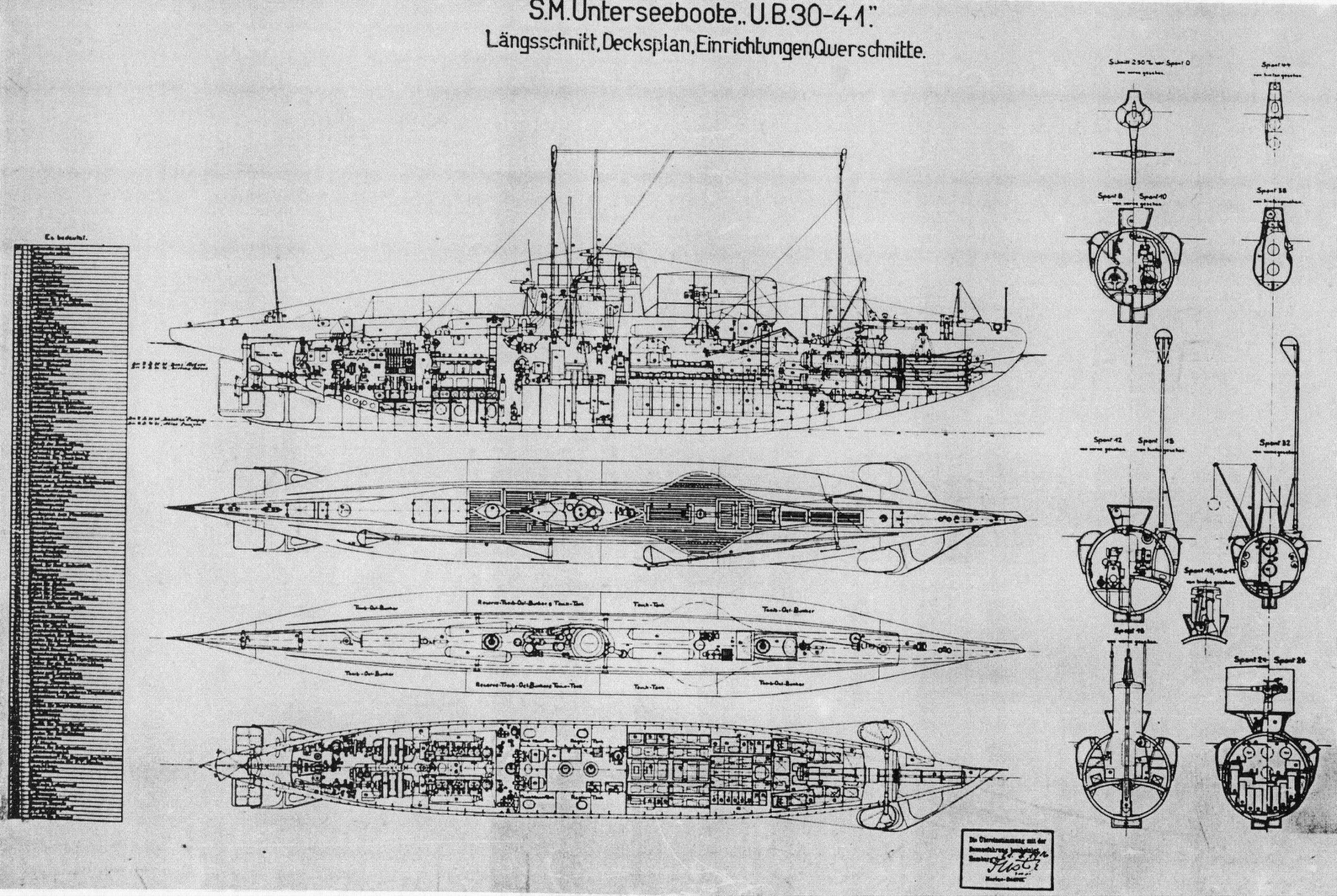
Original plans of the UB-30 sub-serie. Note the fuller hull form, and diving planes aft for better underwater agility.
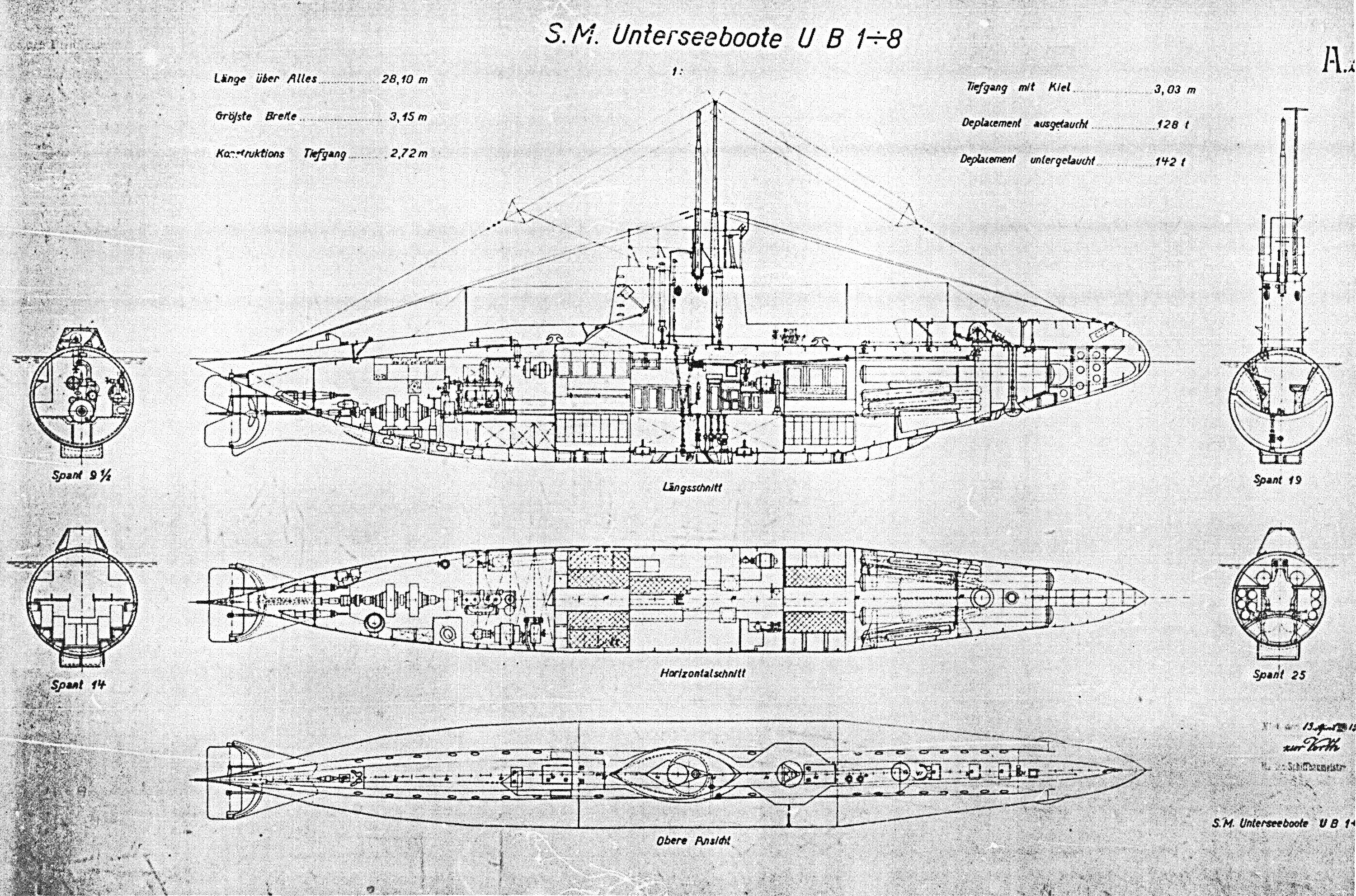
Original plans of the UB-I type to compare
The pressure hull measured 27,13m long for 3,85m in beam (90 ft x 16 ft 6 in).
They were thus larger, and the nose differed in some ways. It was still rounded, with even finer entries thanks to the adoption of tandem tubes, keeping the forward section narrow. It was unlike the UB-I type which had paired tubes forward, creating some bulk. The tandem tubes also brought extra stability. The tubes occupied a large section forward, 1/4 of the total lenght. The rest of the boat was separated into two other compartments, the centre fighting room, with all commands, steering wheel and access to the conning tower. There was also the engine room aft with the paired diesels and batteries arranged in a way to occupied as little space as possible. The diesels were cranked up together on the single shaft.
The hull was dotted with rectangular 34 water scoops, a serie forward and another aft practically to the stern and eight above the tubes. The latter was pointy and overhanging above the rudder/propeller ensemble. There was a single propeller aft with a protective keel below. It started after a progressive rounded curve from the bow on circa 1/3 of the lenght.
The rudder/planes affected a cross shape. The rudder was slightly larger proportionally than on the UB-I type for better agility.
The conning tower was noticeably larger, not taller but longer than on the UB-I. The forward part comprised a small wheelpost, while officers were located behind, with room for perhaps 5 men standing, and a small hatch for access to the command post. It was wrapped in canvas in heavy weather. There was another crew hatch aft of the CT for the crew on deck. The deck was also dotted with water scoops to fill quickly the external ballast hulls when diving. The metal plating were serrated for better grip. The CT contained one main periscope, one anemometer/wind collector mast and a radio mast. Wired were hanging from a trapeze forward of the CT to near-stern plugs and to the bow’s V style support for the forward cable cutting saw, a feature common to all UBs and later on all German U-Boats. The UB-Is lacked this feature.
From the UB-30 onwards however it seems a permanent, rigid structure was installed as a wave-breaker aft of the conning tower. It is shown on all boats until UB-47. It protected officers from heavy weather spray better than canvas, but the steering wheel was still located in front of it. That kind of arched loght shield was a common design. The UB-III however in 1916 went for full “bathtub-style” conning tower, better protecting the crew.
Powerplant and Performances
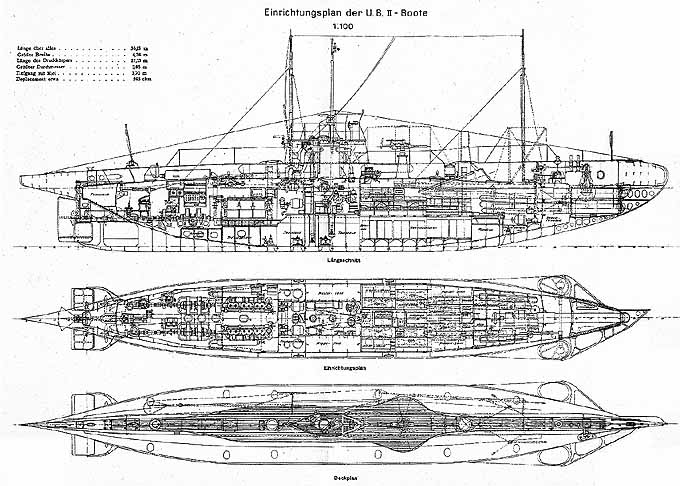
UB-II in the techel archives – It was the direct basis for the interwar U-Boat coastal models, Type II and III.
The UB II featured a single-shaft with a larger three-bladed 1.15 m (3 ft 9 in) propeller, but two engine drive for redundancy, one of the biggest critic about the previous single shaft type. It also featured a much larger battery capacity and larger, better suspended and more reliable engines. Storage batteries were placed forward of the central diving tanks, in order to compensate for the much heavier engines. They also had more fuel oil bunkerage for added range.
Depending on their builders, the powerplant could change:
These could be two Körting, Daimler or Benz diesel engines, 270–284 PS (199–209 kW; 266–280 bhp).
-UB18, 19, 26, 29, 42 – 47: Daimler diesels
-UB20 – 23, 36, 38 – 41: Körting diesels
-UB24, 25, 27, 28, 30 – 35, 37: Benz diesels
However they were paired with the same Siemens-Schuckert electric motors 280 PS (206 kW; 276 shp) in all boats.
Thus, performances would change between models:
UB18-23, 26, 29, 36, 38-47 were rated respectively for 284/280 hp between diesel and electric output
UB24, 25, 27, 28, 30-35, 37 were rated for 270/280 hp.
For top speed, this varied even more:
UB18-23, 36, 38-41 were reported on trials capable of 9.2/5.8 respectively surfaced and underwater.
UB24-29 were capable of 8.9/5.7 kts
UB30-35, 37 were noted at 9.1/5.7 kts
UB42-47 were the slowest surfaced, faster underwater at 8.8/6.2 kts
To compare, the UB-I type were capable of 6.47 knots surfaced and 5.5 knots submerged, so this was quite an improvement in performances. Although not stellar, they were now capable of at least battling strong currents off Flanders and around the great banks of the norther sea with more efficience.

UB-II (BBC photo, via pinterest).
As for range, it was also greatly improved:
UB18-41 carried 28 tonnes of diesel oil and UB42-47 27 tonnes. This gave them various ranges however:
UB18 and UB19, the initial lead boats were reported capable of crossing 6650 nm at 5 knots surfaced, 45 nm at 4 knots underwater.
For UB20-23, 36, 38-41 this was 6450 nm, for UB24-29 7200 nm, for UB30-35, 37 7030 nm and for UB42-47 6940. Always the same underwater range.
To compare again, the UB-I types had the same underwater range, but only 1,650 nmi (3,060 km; 1,900 mi) surfaced at 5 knots so this was a triple increase. They did not needed to be towed off on position before starting their patrol.
As for diving, they were still only able to reach 50 metre in maximum diving depth (or 160 ft, same as before), and diving speed was 30-45 seconds (33 on average on UB-I), so no notable improvement here. This verged again between boats: 45 seconds for the Blohm & Voss boats and 30 seconds in the UB24-UB29 group.
Armament
The armament of the type UB II consisted of two tubes forward, in tandem as said above, so one above the other for a finer bow design for greater surfaced speed (no drag). These wer for 50 cm G torpedoes, but four spare were carried in addition for the two in the tubes. The UB-I only had two spares. It seems however sources states that the normal provision was four, including the two in the tubes, but the missing two were external stern tubes fitted in some boats. It seems 6 torpedoes became the norm after 1916.
Also for surface encounters, the UB-II were far better capable than the UB-I. They indeed had a 5 cm gun at first provided, instead of a 28 mm or a 8 mm (0.31 in) machine gun.
This submarine gun 5cm or 50mm/37 SK L/40 C/92 was installed on the first UB18-29 serie.
For the second batch (UB30-47) it was even augmented to a 88mm/27 TK L/30 C/08 gun, far more capable.

UB-II type drawing in heavy weather (allegedly – pinterest)
Modifications were made during the war:
UB21, 22, 27, 34, 35, 41 in 1916 bow TTs were converted for minelaying, storing 14 amll “P mines”.
In 1916-1917, UB18, 21-25, 27 exchanged their 50mm/37 gun for 88mm/27 TK L/30 C/08 and in 1917 it was also done in the reverse for UB24 (88 replaced by a 50mm/37 SK L/40 C/92).
(Profiles are coming)
⚙ specifications |
|
| Displacement | 263–279 t surfaced, 292–305 t submerged |
| Dimensions | 36.90 m oa x 4.36 x 3.75 m oa (121 ft 1 in x 14 ft 4 in x 12 ft 4 in) |
| Propulsion | 1 shaft, 2x diesel engine 270–284 PS, 2x SS electric motor 280 PS |
| Speed | 8.82–9.15 knots surfaced, 5.71–6.22 knots submerged |
| Range | 6,450–7,200 nmi/5 knots surfaced, 45 nmi/4 knots submerged |
| Armament | 2× 45 cm TTs bow (4-6 Ts), 50/88 mm deck gun, see notes |
| Test depht/diving time | 50 metres (160 ft), 28-40 sec. |
| Crew | 2+21 |
Construction
Thirty boats were made, quite a larger order compare to the UB-I (almost twice as much) but confidence in the design was also far greater.
UB 18-UB 23 were a first batch of six made at Blohm & Voss, Hamburg in 1915-1916 (UB 18 was laid down in early 1915, launched 21 august 1915 and completed by December 1915.
UB 24-UB 29 were the second batch ordered at the same time at A.G. Weser, Bremen. The lead boat UB 24 was launched on 18 October 1915 but completed earllier in November 1915.
UB 30-UB 41 was of the second order, with twelve at Blohm & Voss. The lead boat UB 30 was launched on 16 November 1915 and completed by March 1916
UB 42-UB 47 was a second order to A.G. Weser, Bremen (six boats). The lead boat UB 42 was launched in January and completed by March 1916. The very last of the UB-II serie, UB 47, was completed in July 1916. The battle of Jutland just ended and it seems U-Boates were now a priority.
This led to the UB-III serie, the best of the three by far.
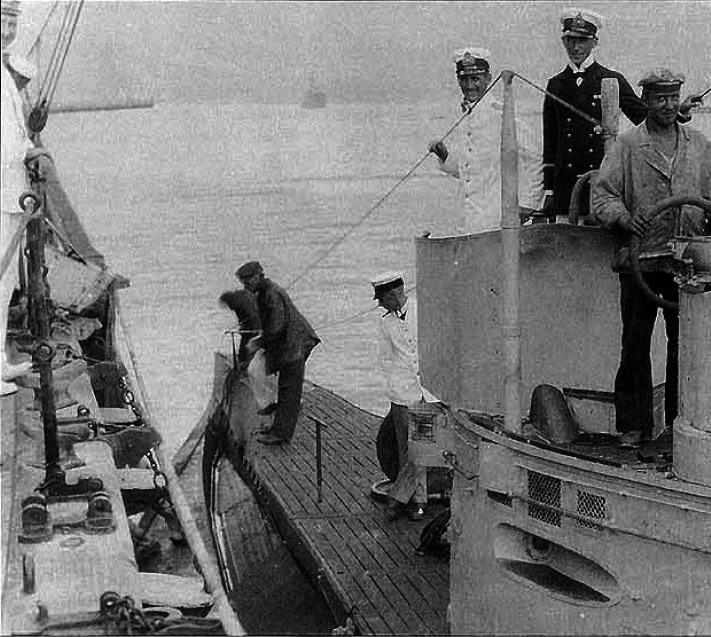
The crew of UB-45 in the Adriatic. UB-45 is the only one from which creative commons pictures are usable.
Critics
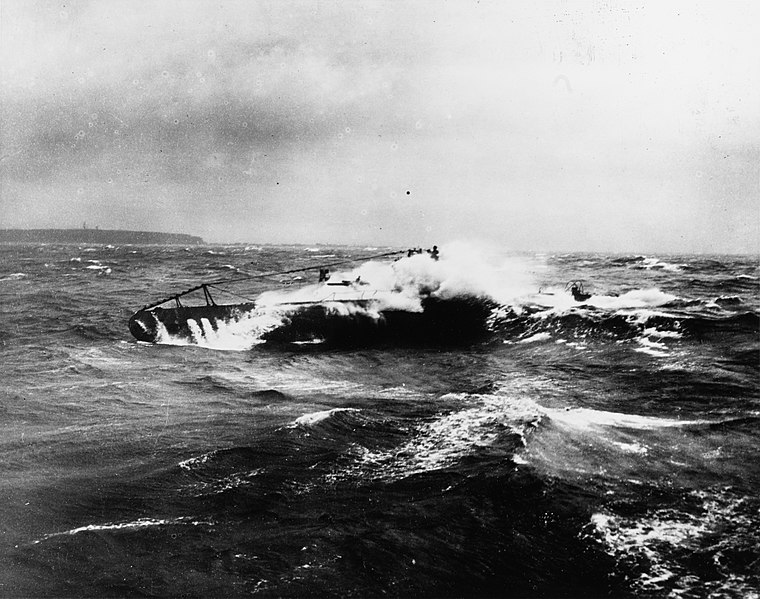
One unidentified UB-II boat tossed by high waves off Heligoland in 1917. These were still too small boats to deal with north sea conditions (cc).
The UB-II was a great improvement in all corners on the UB-I type in 1916, however they were still too small for effective service, albeit as “coastal” models, and in late 1916 some of them were reconverted as minelayers already as soon as the first UB-III types were available.
Captains which compared to other U Boat types of the time still found them underperforming. They were slow at barely 7 knots surfaced in the best condition, the radius of action was still not great for several days operations in safety conditions, they carried too few torpedoes, dove not deeply enough or fast enough, and if the two engines added redundency in case of a failure, the single propeller did not hemp in agility. If damaged, again the U-Boat was unable to proceed to the nearest port. Some of them were sent in the Adriatic, sold to Austria-Hungary in 1917, and 20 were lost, 2/3 of the total engaged, which was massive, despite their “hunting boards” which was far better than the tiny UB-Is. Ordered in the spring and summer of 1915, they carried enough fuel to regularly remain on patrol for two weeks.
They led to a type that was actually rather large for a coastal submarine, but classed as such by comparison to the new generation of oceanic U-Boats and ‘U-Kreuzer” of the Kaiserlisches Marine.
Towards the UB-III and legacy
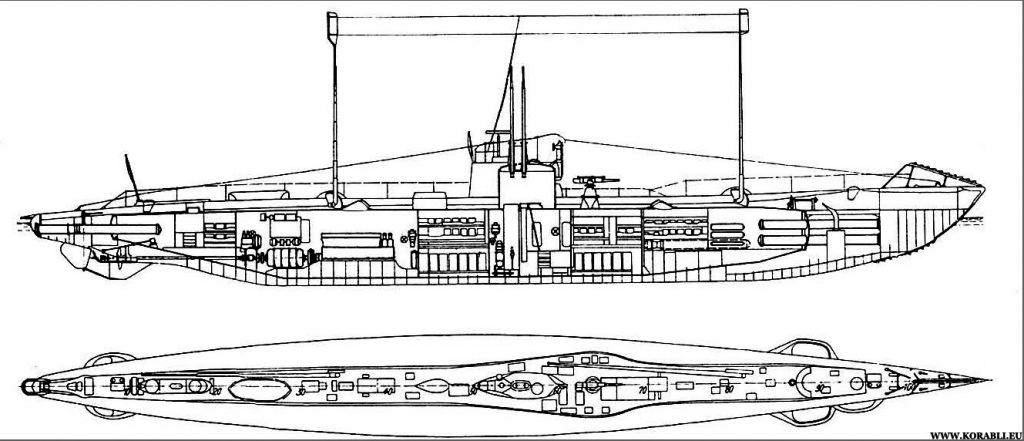
UB-III diagram
The UB-III (next article) was really the game changer. It addressed all the critics of the Ub-II and became the standard “light submarine” of the Kaiserluches Marine. More were built than any other type in WW2, worldwide. This really was the world’s first mass-produced type, predecing the US “S type” by a few years. 201 were planned to be built over two years, but 145 were advanced in construction in 1918, 96 were completed, and 56 Cancelled. They were far larger at close to 680 tonnes submerged had two shafts for agility and redundancy, for a top speed surfaced of 13.2–13.9 knots surfaced and up to 8 kts submerged so that they could catch even the fastest steamers. They also had four 50 cm (19.7 in) bow torpedo tubes and one stern tube plus ten in reserve, as well as a 8.8 cm (3.5 in) SK L/30 or even 10.5 cm (4.1 in) SK L/45 deck gun on the second serie, making them even more deadly when surfaced. In short, they were Kaiser Wilhelm II’s best tool against entente trade, especially in a context of unrestricted warfare.
 The legacy of the UB-II and UB-III also greater than any other type in the German Navy: In the interwar, the UB-II led directly to the design of the U-Boat Type II and Type III, whereas the UB-III not only marked the rebirth of German submarine design at the Hague bureau, Netherlands, exporting several types like the Turkish Birinci Inonu class subs at the origin of the famous Type VII, cornerstone of the Submarine Warfare in WW2. When seeing the UB-III and Type VII it’s obvious the latter was just a grown-up UB-III, the UB-IV type Germany could have built if the great war had dragged on until 1920.
The legacy of the UB-II and UB-III also greater than any other type in the German Navy: In the interwar, the UB-II led directly to the design of the U-Boat Type II and Type III, whereas the UB-III not only marked the rebirth of German submarine design at the Hague bureau, Netherlands, exporting several types like the Turkish Birinci Inonu class subs at the origin of the famous Type VII, cornerstone of the Submarine Warfare in WW2. When seeing the UB-III and Type VII it’s obvious the latter was just a grown-up UB-III, the UB-IV type Germany could have built if the great war had dragged on until 1920.
The UB-II Type in service
The 30 boats built paid a heavy price in operations with 20 sunk in action. They served in the Channel, North sea flotillas, Adriatic (Austria-Hungary) and Ionian sea and well as the black sea.
See later for individual records.
UB43 and UB41 were sold to Austria-Hungary in 1917, recommissioned as U43 and U47. They were ceded to Italy after the war and scrapped.
UB26 (was wrecked on 5.4.1916 on harbour obstructions at Le Havre). Raised postwar she became the French Roland Morillot scrapped in 1931.
UB23 was interned 29.7.1917 at La Coruña, Spain after damaged by depth charges from HMS P60, also French reparation but scrapped.
UB24, UB25, UB28 and UB42 survived, became British war reparations, scrapped.
UB40 was scuttled 5.10.1918 at Ostend during the retreat from Flanders.
UB18 was rammed by British trawler Ben Lawers 9.12.1917 in the Channel and sunk.
UB19 was sunk by Q-ship HMS Penshurst on 30.11.1916 in the Channel.
UB20 hit a mine 29.7.1917 off Flanders coast.
UB22 hit a mine on 19.1.1918 in the North Sea.
UB25 sank in kiel after a collison on 19.3.1917 with V26. Salvaged 22.3.1917, recommissioned, became TS.
UB27 was sunk by ramming/depth charges by sloop HMS Halcyon 29.7.1917, North Sea.
UB29 was sunk 13.12.1916 in Channel by drifting mines and finished off by HMS Landrail.
UB30 was wrecked 23.2.1917 at Walcheren Island. Salvaged by neutral Dutch, interned and returned to Germany in August 1917, recom. sunk 13.8.1918 North Sea by British trawler John Gillman.
UB31 was sunk 2.5.1918 in the Channel by trawlers Lord Leitrim, Loyal Friend and Ocean Roamer.
UB32 was bombed by an aircraft 22.9.1917 in Channel and sunk.
UB33 hit a mine 11.4.1918 in the Channel.
UB35 was sunk by British destroyer HMS Leven and PBs on 26.1.1918, Channel.
UB36 was rammed and sunk by French s/s Molière 21.5.1917, Channel.
UB37 was sunk by Q-ship HMS Penshurst 14.1.1917 in the Channel.
UB38 hit a mine on 8.2.1918 in the Channel.
UB39 same on 15.5.1917 also in the Channel.
UB41 hit a mine (German) on 5.10.1917, North Sea.
UB44 was sunk by British patrol vessels HMS Quarrie, Knowe and Garrigill on 4.8.1916, Ionian Sea.
UB45 hit a mine on 6.11.1916 in the Black Sea and UB46 on 7.12.1916.
 UB-18
UB-18
Commissioned on 10 Dec 1915 she served under Oblt. Franz Wäger from 11 Dec 1915 to 15 Feb 1916 then Oblt. Otto Steinbrinck until 27 Oct 1916 (earned the Pour le Mérite) Oblt. Claus Lafrenz until 7 Jul 1917, Oblt. Ulrich Meier until 21 Sep 1917 and Oblt. Georg Niemeyer until 9 December 1917 all in the Flandern Flotilla, making 31 patrols, and sinking 127 ships (total 130,841 tons) plus 5 ships (7,576 tons) and the auxiliary French minesweeper “Au Revoir” (1025 tons) plus two Q-ships, 4,000 tons Carrigan Head and 158 tonnes Sarah Colebrooke. The rest of her prey comprised a mix of carho, sailing vessels and trawlers. On 9 Dec 1917 she was Rammed and sunk by the trawler Ben Lawer in the Channel with all hands lost.
 UB-19
UB-19
UB 19 was completed on 16 Dec 1915. She operated under Kptlt. Walther Gustav Becker until 3 Nov 1916 and Oblt. Erich Noodt until 30 Nov 1916. From March 1916 after sea trials and training she served with the Flandern Flotilla. She had 13 ships sunk for 10,040 tons (including the British steamer San Bernardo, 3,803 tonnes), damaged the 3,020 tons British Ernaston cargo and took the 1,970 tons Dutch Koningin Regentes Passenger steamer as prize.
On 30 Nov 1916 she was sunk by gunfire from Q-Ship Penshurst, with 8 dead and 16 survivors. She was surfaced at the time and went for inspection when the Q-ship unveiled its hidden artillery and fired point-blank. This explains while most of the crew survived. This was one reason why the Kaiser in the end was pushed to proclaimed unrestricted sub warfare. Many Q-ship were later sunk on sight by UB-II types by the that so their comrades were avenged.
 UB-20
UB-20
Completed on 8 Feb 1916 she was under command from 10 Febrary 1916 to 31 Jan 1917 by Oblt. Max Viebeg (awarded Pour le Mérite) and from 1 Feb 1917 to her sinking on 28 July 1917 by Oblt. Hermann Glimpf, making 15 patrols in the Baltic Flotilla from 12 March 1916 to 26 March 1917 an then in the Flandern Flotilla from 26 March 1917 to her loss. She sank 13 ships (total of 10,230 tons), plus one damaged (7,241 tons SS Knight Companion), and the 1,047 tons Swedish Themis taken as prize.
On 28 July 1917 she hit a mine during a diving trial off Zeebrugge, sinking with all hands.
 UB-21
UB-21
Commissioned on 20 Feb 1916 (comp. 18th) she served until 26 Nov 1916 under Kptlt. Ernst Hashagen, then Oblt. Franz Walther (until 9 Sep 1917), Walter Scheffler (28 Apr 1918), Bruno Mahn (7 Oct 1918), making 26 patrols with the Ist, II, V, Ist and then Training Flotilla from 7 Oct 1918 to 11 November, sinking 33 ships (36,764 tons), damaging the 3,734 tons SS Inverness and taking four steamers as prize for a a total of 2,722 tons. On 24 Nov 1918 she formally Surrendered to the RN and sank off the English East coast on her way to be BU in 1920.
 UB-22
UB-22
Commissioned on 1 Mar 1916 she served until 16 Apr 1917 under Oblt. Bernhard Putzier then until 19 Jan 1918 under Oblt. Karl Wacker making 18 patrols with the I, II and V Flotillas in the north sinking 27 ships (total of 16,645 tons). She was lost with all hands, hitting a mine on 19 January 1918 in the Heligoland Bight. Her biggest “kill” was the 5,690 tonnes Steamer Garthwaite in November 1917, also her very last ship sunk. Again, to put things into perspective, she displaced ten times more than her prey.
 UB-23
UB-23
Commissioned on 11 March 1916 she operated until 9 Nov 1916 undr command of Oblt. Ernst Voigt, then until 5 Feb. 1917 under Heinz Ziemer, until 18 Feb 1917 under Herbert Lefholz, until 19 Mar 1917 until Matthias Graf von Schmettow and until 29 Jully 1917 under Hans Ewald Niemer, making 21 patrols in the Flandern Flotilla with 51 ships sunk (33,880 tons) and a damaged ship of 419 tons. Her biggest kill was British tanker Conch (5,620 tonnes).
On 29 July 1917 she took refuged in neutral Spanish port of Corunna, after being badly damaged by depth charges from the RN patrol boat HMS PC-60, off Cape Lizard three days prior. She managed to escape underwater until there, quite a feat. Sunce it was too dangerous for her to get back in Germany the captain decided internment, thus saving all 23 of her crew, later likely repatriated by a neutral ship.
 UB-24
UB-24
Commissioned on 18 Nov 1915, this U Boat was under command of Oblt. Kurt Albrecht until 12 December 1915. It seems she served as training sub in the Baltic all her career, so making no combat patrol nor kill. On 24 Nov 1918 she formally Surrendered to France, sailing to Cherburg. She was BU at Brest on July 1921.
 UB-25
UB-25
UB 25 was Commissioned on 11 Dec 1915 and served just for her trials until 24 December under Oblt. Hans Nieland, she was also used as training sub until surrendering to the RN on 26 Nov 1918, BU at Canning Town in 1922.
 UB-26
UB-26
Commissioned on 27 December 1915, UB 26 had a short career until Oblt. Wilhelm Smiths until 5 April 1916, caught just at her 2nd patrol as part of the Flandern Flotilla: She was entangled in nets launched by the French destroyer Trombe, had to surface and was inetrned, crew captured and became POWs in France, later she was scuttled in Le Havre Roads. She sank no ship.
 UB-27
UB-27
Commissioned on 23 Febrary 1916, UB 26 served until 31 Oct 1916 under Kptlt. Victor Dieckmann the to 23 Apr 1917 under Oblt. Hans Georg Lübbe and until her sinking on 29 Jul 1917 under Oblt. Freiherr Heinz von Stein zu Lausnitz. Successively she served with the I, II (north sea), Baltic and Flandern Flotillas. She had 11 ships sunk (total 18,091 tons) and three damaged (total 3,240 tons), one 1019 tons took as prize.
On 29 Jul 1917 according to some sources she was caught while surfaced, rammed and then depth charged after she dove, by HMS Halcyon off east coast of UK. Whatever had her, she never reapparead, will all hands.
 UB-28
UB-28
Commissioned on 7 Jan 1916 and under command for sea trials until 13 Jan 1916 by Oblt. Ernst Rosenow, likely used as training boat. On 24 Nov 1918 she Surrendered to the RN, and was BU at Bo’ness in 1919.
 UB-29
UB-29
Commissioned 18 January 1916, UB 28 was commanded until 2 November 1916 by Oblt. Herbert Pustkuchen and until 13 December 1916 by Oblt. Erich Platsch. She served in the training flotilla between 8 March 1916 and 13 December. The remainder was spent in the Flandern Flotilla, making 17 patrols and sinking 36 ships (total 47,107 tons), 2 damaged (3,713 tons), 2 taken as prize (2,170 tons) and damaged a warship, the light cruiser HMS Penelope (3,750 tons).
On 13 Dec 1916 she hit a mine off Ostend and sunk will all hands. Her wreck was rediscovered and identified in 2017 and her position kept hidden as she is now a protected war grave.
 UB-30
UB-30
UB 30 was commissioned on 16 March 1916, under command until 1 Oct 1916 by Kptlt. Kurt Schapler, then until 7 August 1917 by Oblt. Freiherr Cassius von Montigny, until 21 Apr 1918 by Kptlt. Wilhelm Rhein and until 13 August 1918 under Oblt. Rudolf Stier. Untim 23 February 1917 she served with the Baltic Flotilla and then the Flandern Flotilla, performing 19 patrols with 18 ships sunk (total 19,650 tons), 2 damaged (The British 6,544 tons Clan Mackenzie and US 5,463 tons steamer Amenia). On 13 August 1918 she was spotted, submerged, then chased off and Depth charged until lost off the British east coast.
 UB-31
UB-31
Commissioned on 24 Mar 1916 IB 31 served until 11 August 1916 under Oblt. Karl Vesper then until 31 Jan 1918 under Thomas Bieber until loss under Wilhelm Braun in the Baltic and then from 24 February 1917 to 2 May 1918 in the Flandern Flotilla, making 25 patrols, sinking 27 ships (73,811 tons) and 8 damaged (34,699 tons), making her one of the most successful tonnage-wise.
On 2 May 1918 she hit mine in the Strait of Dover, and was lost with all hands.
It should be stressed how much the damage of a standard fixed mine was massive. The blast was enough generally to break the hull in two, and so her pressure hull was filled in a couple of seconds. Otherwise, it just filled a bit slower, but still way faster than the depht charged damaged boats. Slowly filling, this was the worst of the worst for the crew, some preferring to shoot themselves instead of drowning (the crew had a few Luger pistols aboard for self-defence and boading ships).
 UB-32
UB-32
Commissioned on 10 April 1916, UB 32 was commanded by Kptlt. Ludwig Karl Sah until l4 Dec 1916, then until 24 Feb 1917 Oblt. Karl Ruprecht, then until 5 Aug 1917 Kptlt. Max Viebeg (awarded Pour le Mérite) and until 22 Sep 1917 Oblt. Benno von Ditfurth. She made 16 patrols, first with the Baltic Flotilla, then Flandern Flotilla sinking 22 ships (42,893 tons), 4 damaged (19,933 tons).
Her biggest kill was the 11,120 British troopship SS Ballarat. On 22 Sep 1917 as most sources would agree, she was sunk by bombs from an RNAS aircraft off the Belgian coast, one of the first and rare such encounters.
 UB-33
UB-33
Commissioned on 20 April 1916, she served until 30 Jan 1917 under Oblt. Herbert Lefholz then to 21 Mar 1917 under Oblt. Waldemar von Fischer, 16 Sep 1917 under Oblt. Karl Ruprecht and 11 April 1918 under Oblt. Fritz Gregor, making 17 patrols with the Baltic and Flandern Flotilla successively. She sank 13 ships (5,390 tons), damaged 2 ships (6,575 tons), took 3 as prizes.
On 11 April 1918 she hit a mine and sank off the Varne sandbank.
 UB-34
UB-34
Completed in 17 May 1916 she served until 16 March 1917 under Oblt. Theodor Schultz, to 31 Aug 1917 under Oblt. Ludwig Schaafhausen, to 30 Mar 1918 under Oblt. Hellmuth von Ruckteschell, to 8 Sep 1918 under Oblt. Erich Förste and to 6 Oct 1918 under Ltn. (R) Hans Illing, carrying out 21 patrols with the I, II, V, I Flotillas (north/baltic seas), the Flandern Flotilla and TS flotilla from 6 October 1918. She sank 31 ships (39,496 tons), damaged 2 (12,406 tons) and took as prize two (2,210 tons). On 26 Nov 1918 she Surrendered to the entente, attributed to Britain, BU at Canning Town, 1922.
 UB-35
UB-35
Commissioned on 17 Apr 1916, she served until 26 Sep 1916 under Oblt. Rudolf Gebeschus, until 5 Nov 1916 Oblt. Otto von Schrader, until 19 Apr 1917 under Kptlt. Rudolf Gebeschus and until 26 Jan 1918 under Oblt. Karl Stöter, 26 patrols in the I, II, Baltic and Flandern Flotilla, sinking 42 ships (47,739 tons), damaging 2 (642 tons), taking 4 as prize (5,753 tons).
On 26 January 1918 she was depth charged and sank by HMS Leven off Dunkirk.
 UB-36
UB-36
Commissioned on 22 May 1916, she served until 12 Dec 1916 under Oblt. Kurt Albrecht and until 9 May 1917 under Oblt. Harald von Keyserlingk, making 12 patrols in the Baltic and Flandern Flotilla and sinking 7 ships (1,584 tons), taking two as prize. On 9 May 1917 she hit a mine off the Flanders soon after sailing out from Zeebrugge.
 UB-37
UB-37
Commissioned on 10 June 1916 she served until 6 Nov 1916 under Oblt. Hans Valentiner and until 14 January 1917 under Oblt. Paul Günther, making 10 patrols with the Flandern Flotilla, sinking 31 ships (20,504 tons) with 3 damaged (1,622 tons), 1 400 ton vessel taken as prize. On 14 January 1917 she was sunk by gunfire from Q-Ship HMS Penshurst in the middle of the channel between the cotentin peninsula and Southampton.
 UB-38
UB-38
Commissioned on 18 July 1916, UB 38 served until 18 Nov 1916 under Kptlt. Erwin Waßner (awarded Pour le Mérite), then until 5 Dec 1917 under Oblt. Wilhelm Amberger, until 24 Dec 1917 under Oblt. Waldemar von Fischer and until her loss on 8 Feb 1918 under Oblt. Günther Bachmann, carrying 21 patrols all with the Flandern Flotilla. 47 ships sunk (47,476 tons) and the 4,577 tons steamer Teespool damaged. On 8 Feb 1918 while fleeing destroyers after her she ran into a minefield and hit a mine, sinking with all hands off Dunkirk.
 UB-39
UB-39
Completed on 28 Apr 1916, UB 39 was one of the most successful UB-II boat. Sher served until 7 Nov 1916 with Oblt. Werner Fürbringer and then until 7 May 1917 under Oblt. Heinrich Küstner making 14 patrols with the Flandern Flotilla but sinking 93 ships (89,998 tons) plus 4 damaged for 7,215 tons. Her biggest kills were the steamer Clan Macmillan (4525t) and Strathtay (4200t).
On 7 May 1917 she was sunk east of Sandettie Bank with all hands, with historians divided on the cause, mine being likely as the wreck was rediscovered off the Belgian coast.
 UB-40
UB-40
Completed on 18 August 1916, UB 40 got the prize for the most destructive UB-II boat but she did it over a long career. Until 2 Dec 1916 she served under Oblt. Karl Neumann, until 14 Dec 1917 under Oblt. Hans Howaldt (awarded Pour le Mérite), until 17 May 1918 under Oblt. Karl Dobberstein and 31 Jul 1918 under Oblt. Hans Joachim Emsmann.
She made 28 patrols for the Flandern Flotilla sinking a rounded 100 ships (135,617 tons), damaged 16 (60,629 tons) and taken one 470 tons vessel as prize.
Her biggest kill was the 6,311t British steamer Ikeda. She survived the war to be scuttled at Ostende on 5 Oct 1918 during the German evacuation.
 UB-41
UB-41
Commissioned on 25 August 1916, UB 41 served until 20 March 1917 under Oblt. Friedrich Karl Sichart von Sichartshofen, then until 13 Sep 1917 under Oblt. Günther Krause, until 5 Oct 1917 under Oblt. Max Ploen, making 13 patrols in the II and V Flotilla, north sea, sinking 8 ships (8,387 tons), damaged 2, taking 1 as prize. On 5 October she hit a mine north of Scarborough.
 UB-42
UB-42
One of the few which served in the adriatic and then black sea. Commissioned on 23 Mar 1916, UB 42 served under Fritz Wernicken Kurt Schwarz, Erich von Rohrscheidt, Herbert Nolde, Hans Georg Lübbe, Freiherr Cassius von Montigny and Peter Ernst Eiffe, making 21 patrols in the Pola and then Constantinople Flotilla, sinking 11 ships (16,047 tons), 1 taken as prize, one damaged. On 16 November 1918 she surrendered and was disarmed by the Allies at Sevastopol, sent to Malta for BU in 1920. Nominally she served at first under Austro-Hungarian flag but her crew was German.
 UB-43
UB-43
Second boat of the Pola flotilla, UB 43 served from her commission on 24 April 1916 under Oblt. Dietrich Niebuhr until 28 August 1916, until 8 April 1917 with Kptlt. Hans von Mellenthin (awarded Pour le Mérite) and until 15 July 1917 under Oblt. Horst Obermüller, making 10 patrols and sinking 22 ships (99,176 tons), and damaged the 7,350 tons Protected cruiser HMS Grafton. She was for this reason the most successful in that theater. On 6 November 1918 she surrendered at Venice, BU there in 1919.
 UB-44
UB-44
Also a Pola flotilla boat, she was commissioned on 11 May 1916 but had a very short career. She served until her loss on 4 August 1916 under command of Oblt. Franz Wäger, sinking only the 3,409 tons British steamer Moeris. She disappeared while en route from Cattaro to Constantinople, with all hands. So far her wreck never has been foundn cause unknown.
 UB-45
UB-45

The 4th boat of the Pola Flotilla, UB 45 was commissioned on 26 May 1916 and served until her loss under Kptlt. Karl Palis, first with the Pola and then from 12 August 1916 with the Constantinople Flotilla, making 5 patorls, sinking 4 ships (15,361 tons). On 6 November 1916 she hit a mine of Varna while surfaced and sank, but had 5 survivors, likely on deck or in the CT at the time.
 UB-46
UB-46
The 5th boat of the Pola flotilla, UB 46 was commissioned on 12 June 1916 and served under her loss under Kptlt. Cäsar Bauer, making 5 patrols, sinking 4 ships (8,099 tons) between the Pola and from 7 Oct 191, the Constantinople Flotilla, black sea. She hit a Russian mine on 7 Dec 1916 NW of the Bosporus strait, sank with all hands.
 UB-47
UB-47
Last boat of the Pola flotilla, UB 47 was commissioned on 4 July 1916 and served until 31 Mar 1917 under Oblt. Wolfgang Steinbauer (awarded Pour le Mérite) and until 21 Jul 1917 under Oblt. Hans Hermann Wendlandt making 7 patrols for the Pola Flotilla, sinking 20 ships (76,195 tons), plus the French 11,000 tonnes Battleship Gaulois, troopships liners Ivernia (14,278t), and famous Franconia (18,510t), the Italian troopship liner Stampalia (9,000t), plus three more damaged (16,967t) making her the second most successful Uboat of the adriatic for this class. Its hard to tell why she was inactive for the remainder of 1917 and 1918, possibly used for training. She surrendered to France in 1920 and was BU.
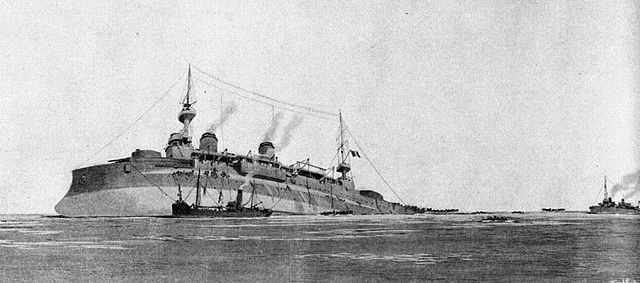
The battleship Gaulois, sunk by UB 47. She has been part of the Dardanelles fleet. Of all the victims of the UB-II boats she was by far the greatets prize. Gaulois sank slowly enough to save most of her crew. She was in the sea of Crete, off the southern coast of Greece when when hit by a single torpedo at 08:03 despite being escorted by the destroyer Dard and two armed trawlers. Her ASW defences were poor and so she had an uncontrollable flooding, having two killed just after the impact, two more drowning as attempting to abandon ship but all the rest rescued as she sunk and capsize slowly in eight minutes off Cape Maleas down under 480–500 metres (1,570–1,640 ft).
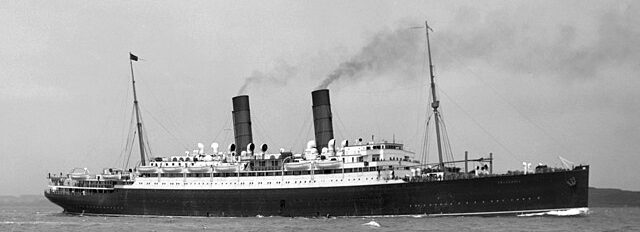
The 1910 Liner Franconia, a Cunard liner also claimed by UB-47 195 miles east of Malta. Fortunately she was not carrying troops but “only” her 314 crew members of which 12 died, the others rescued by the hospital ship Dover Castle. It seems she sank slowly enough thanks to her bulkheads and large buoyancy, the victims mostly being in the lower decks, rapidly flooding.
Read More
Books
Bendert, Harald (2000). Die UB-Boote der Kaiserlichen Marine, 1914-1918. Verlag E.S. Mittler & Sohn GmbH.
Gröner, Erich; Jung, Dieter; Maass, Martin (1991). U-boats and Mine Warfare Vessels. German Warships 1815–1945. Vol. 2. Conways
Preston, Anthony (1978). U-Boats. London, England: Bison Books.
Baumgartner, Lothar; Erwin Sieche (1999). Die Schiffe der k.(u.)k. Kriegsmarine im Bild=Austro-Hungarian warships in photographs978-3-901208-25-6. OCLC 43596931.
Gibson, R. H.; Maurice Prendergast (2003). The German Submarine War, 1914–1918. NIP
Imperial and Royal Navy Association. “Tengeralattjárók” (PDF) Imperial and Royal Navy Association.
Йорданов, Николай (1999). Първата българска подводница (“The First Bulgarian Submarine”)
Jung, Dieter (2004). Die Kaiserliche Marine 1914-1918 und ihr Verbleib. Bernard & Graefe.
Karau, Mark D. (2003). Wielding the Dagger: the MarineKorps Flandern and the German War Effort, 1914–1918. Praeger Publishing.
Messimer, Dwight R. (2002). Verschollen: World War I U-boat losses. NIP
Miller, David (2002). The Illustrated Directory of Submarines of the World. St. Paul, Minnesota
Sokol, Anthony (1968). The Imperial and Royal Austro-Hungarian Navy. NIP
Stern, Robert Cecil (2007). The Hunter Hunted: Submarine versus Submarine: Encounters from World War I to the Present.
Tarrant, V. E. (1989). The U-Boat Offensive: 1914–1945. Annapolis NIP
Williamson, Gordon (2002). U-boats of the Kaiser’s Navy. Oxford: Osprey.
Conway’s All the World’s Fighting Ships 1906–1921
Rossler, Eberhard (1975). The U-boat: The evolution and technical history of German Submarines. Annapolis NIP
Links
https://www.maritima-et-mechanika.org/maritime/models/UBII/ubii.html
https://dubm.de/u-boat-types/?lang=en
http://www.navypedia.org/ships/germany/ger_ss_ub18.htm
http://www.dreadnoughtproject.org/tfs/index.php/UB_II_Type_Submarine_(1915)
https://uboat.net/wwi/types/?type=UB+II
http://German U-boat development during World War I Tomas Termote (PDF)
https://lostinwatersdeep.co.uk/ww1-u-boat-types.html

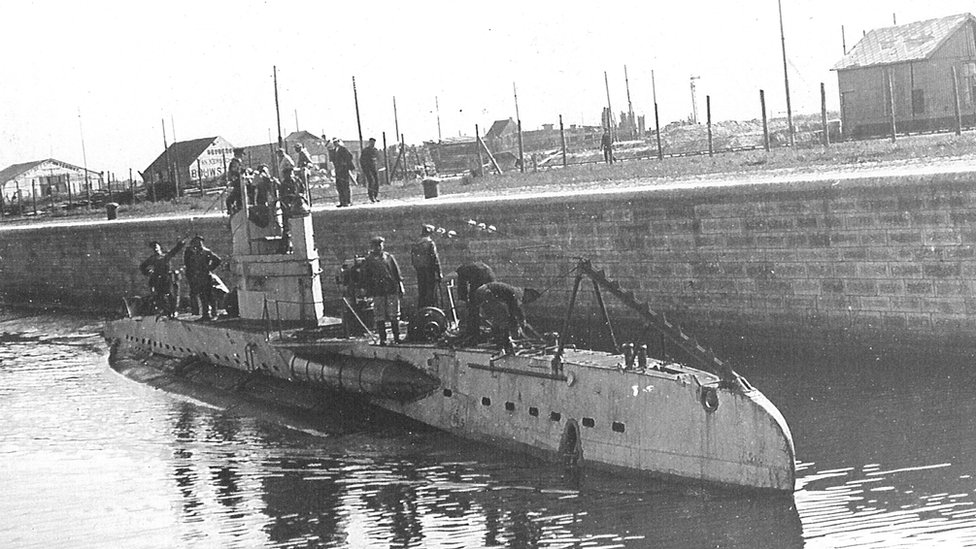
 Latest Facebook Entry -
Latest Facebook Entry -  X(Tweeter) Naval Encyclopedia's deck archive
X(Tweeter) Naval Encyclopedia's deck archive Instagram (@navalencyc)
Instagram (@navalencyc)





 French Navy
French Navy Royal Navy
Royal Navy Russian Navy
Russian Navy Armada Espanola
Armada Espanola Austrian Navy
Austrian Navy K.u.K. Kriegsmarine
K.u.K. Kriegsmarine Dansk Marine
Dansk Marine Nautiko Hellenon
Nautiko Hellenon Koninklije Marine 1870
Koninklije Marine 1870 Marinha do Brasil
Marinha do Brasil Osmanlı Donanması
Osmanlı Donanması Marina Do Peru
Marina Do Peru Marinha do Portugal
Marinha do Portugal Regia Marina 1870
Regia Marina 1870 Nihhon Kaigun 1870
Nihhon Kaigun 1870 Preußische Marine 1870
Preußische Marine 1870 Russkiy Flot 1870
Russkiy Flot 1870 Svenska marinen
Svenska marinen Søværnet
Søværnet Union Navy
Union Navy Confederate Navy
Confederate Navy Armada de Argentina
Armada de Argentina Imperial Chinese Navy
Imperial Chinese Navy Marinha do Portugal
Marinha do Portugal Mexico
Mexico Kaiserliche Marine
Kaiserliche Marine 1898 US Navy
1898 US Navy Sovietskiy Flot
Sovietskiy Flot Royal Canadian Navy
Royal Canadian Navy Royal Australian Navy
Royal Australian Navy RNZN Fleet
RNZN Fleet Chinese Navy 1937
Chinese Navy 1937 Kriegsmarine
Kriegsmarine Chilean Navy
Chilean Navy Danish Navy
Danish Navy Finnish Navy
Finnish Navy Hellenic Navy
Hellenic Navy Polish Navy
Polish Navy Romanian Navy
Romanian Navy Turkish Navy
Turkish Navy Royal Yugoslav Navy
Royal Yugoslav Navy Royal Thai Navy
Royal Thai Navy Minor Navies
Minor Navies Albania
Albania Austria
Austria Belgium
Belgium Columbia
Columbia Costa Rica
Costa Rica Cuba
Cuba Czechoslovakia
Czechoslovakia Dominican Republic
Dominican Republic Haiti
Haiti Hungary
Hungary Honduras
Honduras Estonia
Estonia Iceland
Iceland Eire
Eire Equador
Equador Iran
Iran Iraq
Iraq Latvia
Latvia Liberia
Liberia Lithuania
Lithuania Mandchukuo
Mandchukuo Morocco
Morocco Nicaragua
Nicaragua Persia
Persia San Salvador
San Salvador Sarawak
Sarawak Uruguay
Uruguay Venezuela
Venezuela Zanzibar
Zanzibar Warsaw Pact Navies
Warsaw Pact Navies Bulgaria
Bulgaria Hungary
Hungary

 Bundesmarine
Bundesmarine Dutch Navy
Dutch Navy Hellenic Navy
Hellenic Navy Marina Militare
Marina Militare Yugoslav Navy
Yugoslav Navy Chinese Navy
Chinese Navy Indian Navy
Indian Navy Indonesian Navy
Indonesian Navy JMSDF
JMSDF North Korean Navy
North Korean Navy Pakistani Navy
Pakistani Navy Philippines Navy
Philippines Navy ROKN
ROKN Rep. of Singapore Navy
Rep. of Singapore Navy Taiwanese Navy
Taiwanese Navy IDF Navy
IDF Navy Saudi Navy
Saudi Navy Royal New Zealand Navy
Royal New Zealand Navy Egyptian Navy
Egyptian Navy South African Navy
South African Navy






























 Ukrainian Navy
Ukrainian Navy dbodesign
dbodesign